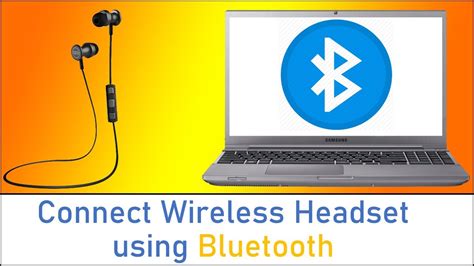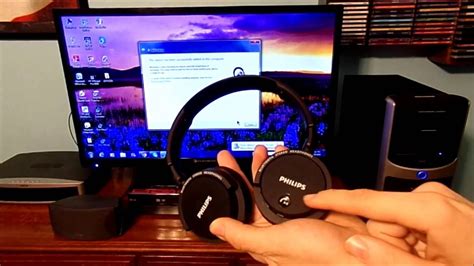If you relish the freedom of a wire-free audio experience and desire the convenience of connectivity across various gadgets, this guide is tailored for you. Say farewell to the tangled mess of cables and embrace the versatility of effortlessly pairing your favorite wireless headphones with your trusted devices.
Unlock the Potential of Seamless Audio Integration
With the ever-evolving technology landscape, it has become increasingly important to stay connected in a fast-paced world. Whether you revel in the enchanting beats of your favorite tunes or crave the clarity of crystal-clear phone calls, ensuring a smooth connection between your wireless headset and your gadgets is paramount.
Experience the Ultimate Pairing Convenience
Regardless of whether you are a restless individual who is always on the move or a tech-savvy enthusiast exploring new horizons, the ability to connect your wireless headphones to your computer and phone is indispensable. Seamlessly switch between your devices without missing a beat, and indulge in uncompromised audio quality.
Pairing Wireless Headphones with a Desktop or Laptop

In this section, we will explore the steps to connect wireless headphones to a desktop or laptop device. We will walk through the process of establishing a connection between your headphones and the computer using Bluetooth technology.
- Turn on your wireless headphones and make sure they are in pairing mode.
- Go to the Bluetooth settings on your computer. This can usually be found in the system tray or in the settings menu.
- Enable Bluetooth if it is not already turned on.
- Click on the option to "Add a Bluetooth device" or "Pair a new device."
- A list of available Bluetooth devices will appear. Look for your headphones in the list and select them.
- Follow any additional on-screen prompts to complete the pairing process.
- Once the pairing is successful, you will see a notification confirming the connection.
- Test the connection by playing audio or video on your computer and checking if the sound is coming through your headphones.
With these simple steps, you can easily pair your wireless headphones with your computer, enabling you to enjoy a wire-free listening experience.
Step-by-Step Guide: Wireless Headphones Connection to Your Personal Computer
When it comes to enjoying your favorite music or watching movies without any hindrance, wireless headphones are a great option. Connecting wireless headphones to your personal computer is a simple and convenient process that enhances your listening experience in a wire-free manner. Follow these step-by-step instructions to establish a seamless connection between your computer and wireless headphones.
- Make sure your wireless headphones are charged and turned on. It is essential to ensure that they have enough battery power to establish a stable connection.
- Access the Bluetooth settings on your personal computer. Usually, this can be done through the "Settings" icon available on the taskbar or by searching for "Bluetooth" in the system settings.
- Once in the Bluetooth settings, toggle the Bluetooth button to turn it on. This enables your computer to search for nearby Bluetooth devices, including wireless headphones.
- Put your wireless headphones into pairing mode. This can usually be done by pressing and holding the power button or a dedicated pairing button, which may vary depending on the headphone model. Consult the user manual for specific instructions.
- Within the Bluetooth settings on your computer, click on the option to "Add Bluetooth or other device" or "Add device." This initiates the pairing process.
- Your computer will then display a list of available Bluetooth devices. Locate the name or model number of your wireless headphones and click on it to select it for pairing.
- Follow any on-screen instructions that may appear to complete the pairing process. This may involve entering a passcode or confirming a connection request on both your computer and headphones.
- Once the pairing process is successfully completed, your computer will display a confirmation message, and your wireless headphones will be connected. You can now enjoy your audio content without the hassle of wires.
Remember, the exact steps may vary slightly depending on the operating system and headphone model you are using. By following this step-by-step guide, you can connect your wireless headphones to your personal computer effortlessly and delve into an immersive audio experience.
Pairing Wireless Headsets with your Mobile Device

In this section, we will guide you through the process of connecting your wireless headphones to your mobile device seamlessly. By performing the pairing process correctly, you can enjoy a hassle-free and uninterrupted audio experience on your phone.
- Step 1: Make sure that both your wireless headphones and mobile device have Bluetooth functionality enabled. This will allow them to detect and communicate with each other.
- Step 2: Access the Bluetooth settings on your mobile device. This can usually be found in the "Settings" menu, or in the quick access panel.
- Step 3: Within the Bluetooth settings, look for an option to "Pair" or "Connect" a new device. Tap on this option to start the pairing process.
- Step 4: Put your wireless headphones into pairing mode. Each model may have a different method to activate pairing mode, such as pressing and holding a designated button or switch.
- Step 5: Once your headphones are in pairing mode, they should appear in the list of available devices on your mobile device's Bluetooth settings screen. Select the corresponding entry to initiate the pairing process.
- Step 6: Follow any additional prompts on your mobile device's screen to complete the pairing process. This may include entering a passcode or confirming a connection request.
- Step 7: After a successful pairing, your wireless headphones should be connected to your mobile device. You can now enjoy wireless audio playback, take calls, and control volume directly from your headphones.
By following these steps, you can easily pair your Bluetooth-enabled headphones with your mobile device, allowing you to enjoy your favorite music, podcasts, and more, without the hassle of tangled wires. Remember, the specific steps may vary slightly depending on your headphone model and mobile device, so it's always a good idea to refer to the user manuals for precise instructions.
Effortless Methods to Pair your Wireless Earphones with your Smartphone
Are you tired of dealing with tangled wires while enjoying your favorite music or taking important calls on your smartphone? Look no further, as connecting your wireless headphones to your smartphone is a breeze. In this section, we will explore simple and effective ways to seamlessly pair your wireless headphones with your smartphone, allowing you to experience the freedom of wireless audio without any hassle. Dive in and discover the hassle-free techniques below!
1. Bluetooth Pairing: The most common and convenient method to connect wireless headphones to your smartphone is through Bluetooth pairing. This wireless technology enables seamless audio transmission between your headphones and smartphone. Simply navigate to the Bluetooth settings on your smartphone, activate pairing mode on your headphones, wait for the devices to discover each other, and voila! Enjoy uninterrupted wireless audio on your smartphone.
2. NFC Pairing: If your wireless headphones and smartphones support Near Field Communication (NFC), take advantage of this quick and easy pairing method. Just tap your headphones against your smartphone's NFC-enabled area, and the devices will automatically establish a connection. Within seconds, you can immerse yourself in your music or engage in crystal-clear phone conversations without the hassle of wires.
3. Mobile App Pairing: Some wireless headphones come with dedicated mobile apps that enhance your audio experience. Install the app on your smartphone, follow the guided setup, and let the app handle the pairing process. These apps often offer additional features like customizable sound settings, equalizers, and firmware updates for your headphones, adding value to your wireless audio experience.
4. Voice Assistant Pairing: If voice commands are your preferred method of interaction, take advantage of voice assistant pairing. Many wireless headphones and smartphones support popular voice assistants like Siri, Google Assistant, or Alexa. Simply say the activation command, followed by the pairing request, and your voice assistant will take care of the rest. This hands-free approach streamlines the pairing process, allowing you to connect your wireless headphones effortlessly.
5. Manual Pairing via Audio Settings: In some cases, manual pairing may be required to connect wireless headphones to your smartphone. Navigate to the audio settings on your phone, select the option to add a new device, and follow the on-screen instructions. Although it may involve a few extra steps, this method ensures a reliable and stable connection between your wireless headphones and smartphone.
With these user-friendly methods at your disposal, you can now connect your wireless headphones to your smartphone effortlessly. Say goodbye to tangled cables and embrace the freedom of wireless audio on your favorite device. Experience the joy of immersive music, clear conversations, and seamless audio by following any of these hassle-free pairing techniques. Enjoy your wireless audio journey!
Troubleshooting Connection Issues with Wireless Earphones and Mobile Devices

In the world of wireless audio, it is not uncommon to encounter challenges when attempting to establish a connection between your preferred wireless earphones and your mobile devices. In this section, we will address common issues that can arise and provide troubleshooting strategies to help you overcome these obstacles.
| Problem | Possible Solution |
|---|---|
| Intermittent or Weak Connection | 1. Ensure that the wireless earphones are fully charged and within the recommended range of your mobile device. 2. Remove any obstacles or sources of interference that may be affecting the signal strength. 3. Reset the wireless earphones and reconnect them to your mobile device. 4. Update the firmware of both the earphones and your mobile device to the latest version. |
| No Sound or Poor Audio Quality | 1. Verify that the volume on both your mobile device and the wireless earphones is appropriately adjusted. 2. Clean the earphone's audio output jack and ensure it is free from debris or dust. 3. Disable any active noise-canceling settings or equalizer presets on your mobile device. 4. Try pairing and connecting the earphones with a different mobile device to determine if the issue lies with the earphones or your current device. |
| Unable to Pair the Devices | 1. Ensure that the wireless earphones are in pairing mode and discoverable by your mobile device. 2. Restart both the earphones and your mobile device, then attempt the pairing process again. 3. Check if the wireless earphones have already been paired with another device and delete that pairing history. 4. Consult the user manual or manufacturer's website for specific instructions on how to pair your particular model of wireless earphones with your mobile device. |
By following these troubleshooting steps, you can increase the likelihood of successfully connecting your wireless earphones to your mobile devices. Remember to refer to the user manual for your specific earphone model for any additional guidance.
Common issues and resolutions when pairing headphones with devices
When attempting to connect your wireless headphones to your electronic devices, you may encounter various challenges that can interrupt the seamless pairing process. Understanding and troubleshooting these common problems can help you successfully establish a reliable connection.
1. Pairing failure: One of the most frequent issues is when the headphones fail to pair or connect with the device. This can be caused by incompatible device settings, outdated Bluetooth drivers, or interference from other devices. To resolve this, ensure that the headphones and the device are in pairing mode, update Bluetooth drivers, and keep them away from other electronic devices.
2. Weak or intermittent connection: A weak or unstable Bluetooth connection can disrupt audio playback and affect the overall listening experience. This issue can be caused by physical obstacles or interference from other wireless devices. To address this, keep the headphones in close proximity to the paired device, remove any barriers between them, and minimize the use of other wireless devices in the vicinity.
3. Audio lag or latency: When using Bluetooth headphones, you may experience a delay between the audio being played and the sound reaching your ears. This latency can be frustrating, especially when watching videos or playing games. To mitigate audio lag, ensure that both the headphones and the device support low-latency codecs, or consider using wired headphones for activities that require real-time audio synchronization.
4. Inadequate sound quality: Sometimes, headphones may offer poor sound quality after connecting to a device. This could be due to incompatible audio codecs, incorrect audio settings, or low battery power in the headphones. To improve sound quality, check the supported audio codecs on both your headphones and the device, adjust audio settings if necessary, and ensure the headphones are adequately charged.
5. Difficulty in switching between devices: Some headphones support multi-device connectivity, allowing you to switch seamlessly between different devices. However, you may encounter difficulties when switching between devices, such as delays or connectivity issues. To resolve this, ensure that all devices are within range, unpair and re-pair the headphones with the desired device, and update any necessary firmware.
By being aware of these common problems and their solutions, you can overcome any obstacles that may arise when connecting your headphones to various devices. Troubleshooting techniques mentioned here can help enhance your overall experience and ensure a smooth and uninterrupted wireless audio connection.
Ensuring a Stable Wireless Connection for Your Audio Device

When it comes to enjoying music or taking calls wirelessly, a stable connection is crucial for an uninterrupted listening experience. In this section, we will explore some key factors to consider in order to ensure a reliable wireless connection for your audio device, be it headphones, earbuds, or a speaker.
1. Positioning: Proper placement of your audio device and the device it is paired with plays a significant role in maintaining a stable Bluetooth connection. Make sure there are no obstructions between the devices and keep them within a reasonable range from each other.
2. Interference: Wireless signals can be prone to interference from other electronic devices, such as Wi-Fi routers, microwave ovens, and cordless phones. Keep your audio device away from potential sources of interference to minimize signal disruption.
3. Battery Life: Low battery levels can weaken the Bluetooth connection. Ensure that your audio device and the paired device have sufficient battery power to maintain a stable connection. Charging your devices regularly can help prevent unexpected disconnections.
4. Firmware Updates: Manufacturers often release firmware updates for Bluetooth devices to improve their performance and stability. Check for any available updates for your audio device and apply them as necessary to optimize the Bluetooth connection.
5. Pairing Optimization: When initially pairing your audio device, follow the manufacturer's instructions carefully. Some devices require specific steps for successful pairing. Additionally, try deleting any existing pairings and re-pairing your devices if you are experiencing connectivity issues.
6. Troubleshooting: If you encounter connection problems, refer to the user manual or reach out to the manufacturer's support for troubleshooting tips. They may have specific solutions for overcoming common Bluetooth connectivity issues.
By implementing these strategies, you can enhance the stability and reliability of your wireless connection, allowing you to enjoy your music or calls without any interruption.
[MOVIES] [/MOVIES] [/MOVIES_ENABLED]FAQ
How do I connect Bluetooth headphones to my computer?
To connect Bluetooth headphones to your computer, first make sure that your computer has Bluetooth capability. Then, turn on your Bluetooth headphones and put them in pairing mode. On your computer, go to the Bluetooth settings and search for available devices. Select your headphones from the list and click on "Pair" or "Connect". Once the pairing is successful, you will be able to use your Bluetooth headphones with your computer.
Can I connect Bluetooth headphones to my phone and computer at the same time?
Yes, it is possible to connect Bluetooth headphones to both your phone and computer at the same time, as long as your headphones support multipoint connectivity. With multipoint connectivity, your headphones can be paired with multiple devices simultaneously. Simply follow the pairing instructions for both the phone and computer, and make sure to turn on the Bluetooth function on both devices. Once paired, you can switch between using your headphones with your phone or computer without having to reconnect each time.
What should I do if my computer or phone is not recognizing my Bluetooth headphones?
If your computer or phone is not recognizing your Bluetooth headphones, there are a few troubleshooting steps you can try. First, make sure that your headphones are in pairing mode and that Bluetooth is enabled on your device. You can also try restarting your computer or phone, as sometimes a simple restart can resolve connectivity issues. Additionally, check if there are any software or driver updates available for your device, as installing the latest updates may help resolve compatibility issues. If the problem persists, you may need to consult the user manual or contact the manufacturer for further assistance.




